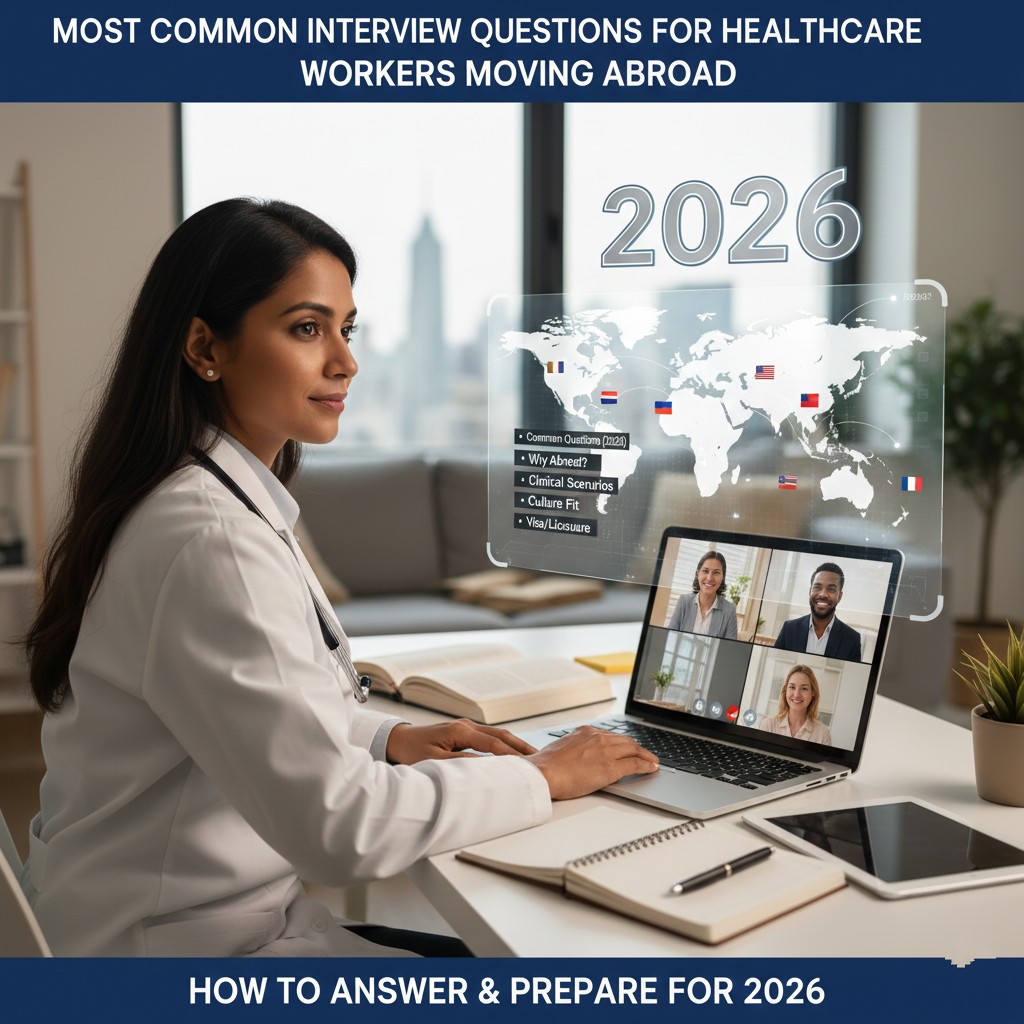For internationally educated healthcare professionals, standing out in a competitive global job market requires more than just a degree and experience. The right certifications can be the decisive factor that fast-tracks your visa application, satisfies stringent licensing bodies, and lands you a job offer in your dream destination.
This guide covers the top certifications that boost healthcare migration prospects, detailing which ones are valued by immigration authorities and employers in countries like Canada, the USA, the UK, and Australia.
Why Certifications Matter for Healthcare Migration
In the context of immigration, certifications serve three crucial purposes:
- Proof of Competency: They validate that your skills meet the specific standards of the destination country.
- Licensing Requirement: For regulated professions, they are non-negotiable for obtaining a work license.
- CRS/Points Boost: Certain certifications can directly increase your points in systems like Canada’s Express Entry or Australia’s SkillSelect.
The Ultimate List of High-Value Certifications by Profession
For All Healthcare Professionals: The Foundation Certifications
These are essential for almost every healthcare role in English-speaking countries.
1. High-Stakes English Language Tests
This is your most important first certification.
- IELTS Academic/General Training or CELPIP (for Canada):
- Why it Matters: A minimum score (usually CLB 7 or above) is mandatory for both licensing and visa applications in most countries.
- Migration Benefit: Directly adds points to your Express Entry CRS score. Higher scores (CLB 9+) can give you a significant edge.
- OET (Occupational English Test):
- Why it Matters: Specifically designed for healthcare professionals. It is widely accepted by regulatory bodies like the NMC (UK), NMBI (Ireland), and Ahpra (Australia).
- Migration Benefit: Often preferred by healthcare employers as it tests language in a medical context, demonstrating you can communicate effectively with patients and colleagues.
2. Advanced Cardiac Life Support (ACLS) & Basic Life Support (BLS)
- Why it Matters: These are the global gold standard for emergency response. They demonstrate your proficiency in handling cardiac and respiratory emergencies.
- Migration Benefit: Highly valued by hospitals in the US, Canada, Australia, and the Middle East. Having an ACLS/BLS certification from a recognized provider (like the American Heart Association – AHA) makes your application instantly more attractive to employers, as it reduces their training burden.
For Nurses: Specialized Credentials for Maximum Impact
3. NCLEX-RN or NCLEX-PN (for USA & Canada)
- Why it Matters: This isn’t just a certification; it’s the licensing examination to become a Registered Nurse or Practical Nurse in the U.S. and Canada.
- Migration Benefit: Passing the NCLEX is the single most important step for nurse migration to North America. A passed NCLEX, even before having a job offer, shows employers you are serious and have already cleared the biggest hurdle.
4. Certified Speciality Credentials (e.g., CCRN, CMSRN, ONC)
- Why it Matters: Certifications like the Critical Care Registered Nurse (CCRN), Medical-Surgical Nursing Certification (CMSRN), or Orthopaedic Nurse Certified (ONC) demonstrate expertise in a high-demand niche.
- Migration Benefit: Specialists are often prioritized for immigration. Employers in countries facing shortages (like the UK and Canada) are more likely to sponsor a nurse with a proven specialty, as they are harder to find locally.
For Doctors: Targeted Examinations for Licensing
5. USMLE (United States Medical Licensing Examination) Steps
- Why it Matters: The USMLE is a three-step examination for medical licensure in the United States. Passing Steps 1 and 2 CK/CS is a prerequisite for entering the residency match program.
- Migration Benefit: While a long pathway, completing the USMLE is the only route to practicing independently as a physician in the U.S. ECFMG Certification (which requires passing USMLE steps) is essential.
6. PLAB (Professional and Linguistic Assessments Board) or UKMLA (UK Medical Licensing Assessment)
- Why it Matters: The PLAB test is the main route for International Medical Graduates (IMGs) to demonstrate the knowledge and skills to work in the UK. It is being replaced/incorporated into the UKMLA.
- Migration Benefit: Passing PLAB/UKMLA Part 1 is often a requirement for securing a job offer within the UK’s NHS, which then leads to a Health and Care Worker Visa.
For Allied Health Professionals: Profession-Specific Licenses
7. CSMLS Certification (for Medical Laboratory Technologists in Canada)
- Why it Matters: The Canadian Society for Medical Laboratory Science (CSMLS) certification is the national standard for MLTs in Canada. It is often required for provincial licensure.
- Migration Benefit: Having this certification makes you immediately employable across Canada and is a highly respected credential that strengthens your Express Entry profile.
8. CAPR Credentials (for Physiotherapists in Canada)
- Why it Matters: The Canadian Alliance of Physiotherapy Regulators (CAPR) administers the written and clinical exams required to practice in Canada.
- Migration Benefit: Completing the CAPR process is a prerequisite for licensure in most Canadian provinces, making it a non-negotiable and powerful credential for migration.
For Senior Caregivers: Niche Certifications
9. First Aid & CPR/AED Certification
- Why it Matters: A basic but mandatory requirement for almost all caregiver roles in Canada, Australia, and the UK.
- Migration Benefit: While simple, not having it can get your application rejected immediately. Having a current, nationally recognized certificate is a basic filter for employers.
10. Certifications in Dementia Care, Palliative Care, or Disability Support
- Why it Matters: These demonstrate specialized knowledge in caring for specific, high-needs populations.
- Migration Benefit: With aging populations in developed countries, expertise in dementia and palliative care is in extremely high demand. Highlighting these certifications can make you a preferred candidate for sponsored roles.

How to Choose the Right Certifications for Your Goals
- Identify Your Target Country: Research the mandatory licensing requirements first. Your primary goal should be to obtain the certification that grants you a license to practice there (e.g., NCLEX for Canada/US, NMC registration for the UK).
- Analyze In-Demand Specialties: Look at the official shortage lists (e.g., Canada’s Express Entry category-based draws, Australia’s Skilled Occupation List). Certifications in these specialties (e.g., Critical Care, Perioperative Nursing) will give you the biggest advantage.
- Consider Portability: Certifications from internationally recognized bodies like the American Heart Association (AHA) are valued globally, whereas some local certifications may not be.
Strategic Tips for Certification Success
- Start Early: Many of these exams require months of preparation.
- Verify Recognition: Ensure the certifying body is recognized by the regulatory college in your target country/province.
- Budget accordingly: Exam fees, preparation courses, and potential travel can be costly. Plan your finances.
- Leverage Your Credentials: Once certified, update your CV, LinkedIn profile, and Express Entry profile immediately to reflect your new qualifications.
Your Action Plan for 2025
- Step 1: Book and prepare for your language test (IELTS/CELPIP/OET).
- Step 2: Research the mandatory licensing exam for your profession and country (e.g., NCLEX, PLAB, CSMLS).
- Step 3: Invest in specialty certifications (ACLS, CCRN) relevant to your experience and market demand.
- Step 4: Obtain and maintain core safety certifications like BLS/First Aid.
Investing in the right certifications is a powerful strategy to demonstrate your commitment, competence, and readiness to integrate into a new healthcare system. By strategically choosing and obtaining these credentials, you don’t just improve your resume—you dramatically increase your chances of a successful and speedy healthcare migration.
Your passport to global opportunity is not just your degree—it’s the certifications that validate it. Start your journey today!


















